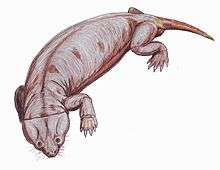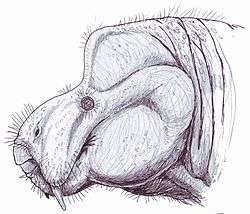Cistecephalidae
Cistecephalidae is an extinct family of dicynodont therapsids from the Late Permian of South Africa, India and Zambia. It includes the genera Cistecephalus, Cistecephaloides, and Kawingasaurus.[1] Cistecephalids are thought to have had a fossorial or burrowing lifestyle, with adaptations such as broad skulls, strong forelimbs, and squat bodies. A similar group of dicynodonts called the pylaecephalids were also fossorial, although to a lesser extent than cistecephalids.[2] Cistecephalids showed a high level of endemism, with each of the five known species unique to a single region.[3]
| Cistecephalidae Temporal range: Late Permian | |
|---|---|
 | |
| Reconstruction of Cistecephalus microrhinus | |
| Scientific classification | |
| Kingdom: | Animalia |
| Phylum: | Chordata |
| Clade: | Therapsida |
| Clade: | †Dicynodontia |
| Stem group: | †Kistecephalia |
| Family: | †Cistecephalidae Broom, 1913 |
| Genera | |
Description
Cistecephalids were small dicynodonts. Most species, with the exception of Kembawacela, lacked tusks, but sexually dimorphic supraorbital ridges were present.[3][4] Cistecephalids had boxy, broad skulls with relatively laterally directed temporal openings, a result of a considerably broadened intertemporal region. Sauroscaptor, the most basal genus of the family, had a less extreme broadening of the intratemporal region than in other members of the family.[3] In the derived genera Cistecephaloides and Kawingasaurus, the intratemporal portion of the skull was broader than the skull was long. Cistecephalids also had a relatively posteriorly positioned pineal foramen, which in Kembawacela and Sauroscaptor was displaced all the way to the posterior margin of the skull. They also had anteriorly directed orbits; they may have had binocular vision, which may have been an adaptation for nocturnality or an insectivorous lifestyle.[4]
Classification
The Cistecephalidae contains five named genera each with one species. It is a member of the Dicynodont clade Emydopoidea. Phylogeny following Kammerer et al. 2016:[1][3]
| |||||||||||||||||||||||||||||||||||||||||||||||||||||||||||||||||||||||||||||||
References
- Kammerer, C.F.; Angielczyk, K.D. (2009). "A proposed higher taxonomy of anomodont therapsids" (PDF). Zootaxa. 2018: 1–24.
- Ray, S.; Chinsamy, A. (2003). "Functional aspects of the postcranial anatomy of the Permian dicynodont Diictodon and their ecological implications". Palaeontology. 46 (1): 151–183. doi:10.1111/1475-4983.00292.
- Kammerer, C. F.; Bandyopadhyay, Saswati; Ray, Sanghamitra (2016). "A new taxon of cisticephalid dicynodont from the upper Permian Kundaram Formation of India". Papers in Palaeontology. 2 (4): 569–584. doi:10.1002/spp2.1055.
- Nasterlack, Tobias; Canoville, Aurore; Chinsamy, Anusuya (2012). "New insights into the biology of the Permian genus Cistecephalus (Therapsida, Dicynodontia)". Journal of Vertebrate Paleontology. 32 (6): 1396–1410. doi:10.1080/02724634.2012.697410. JSTOR 23361056.
